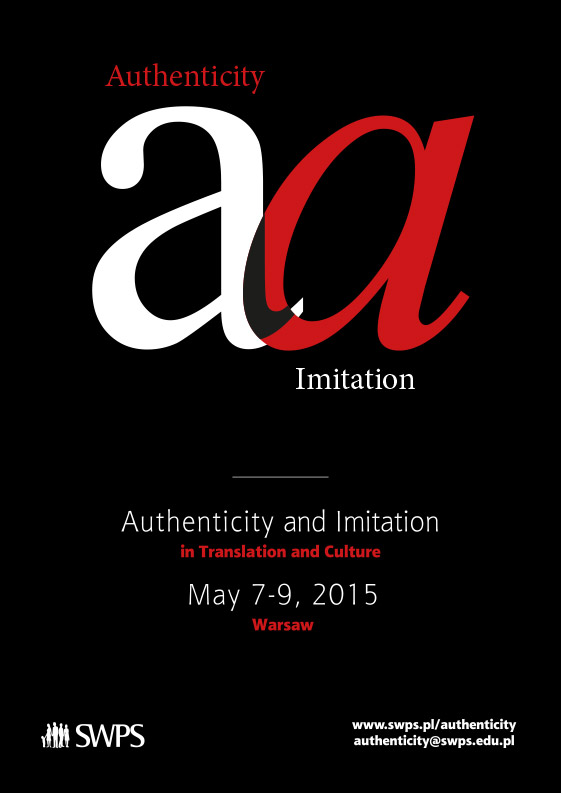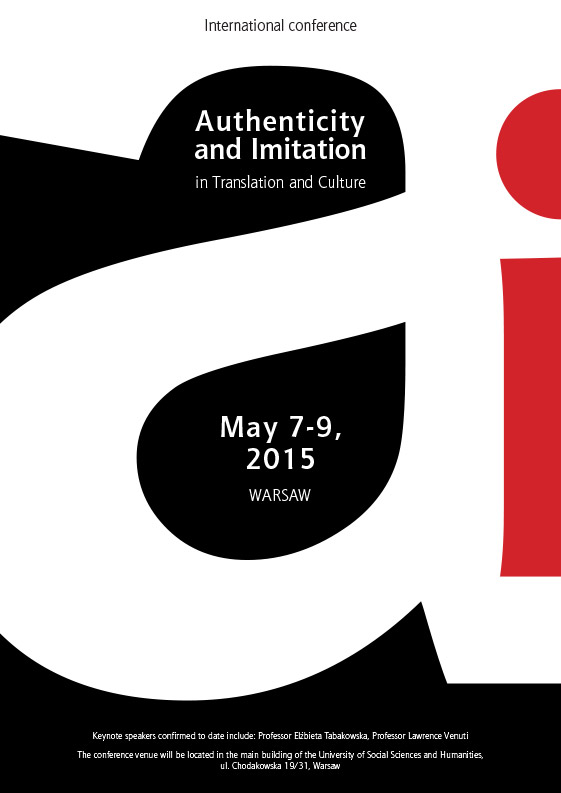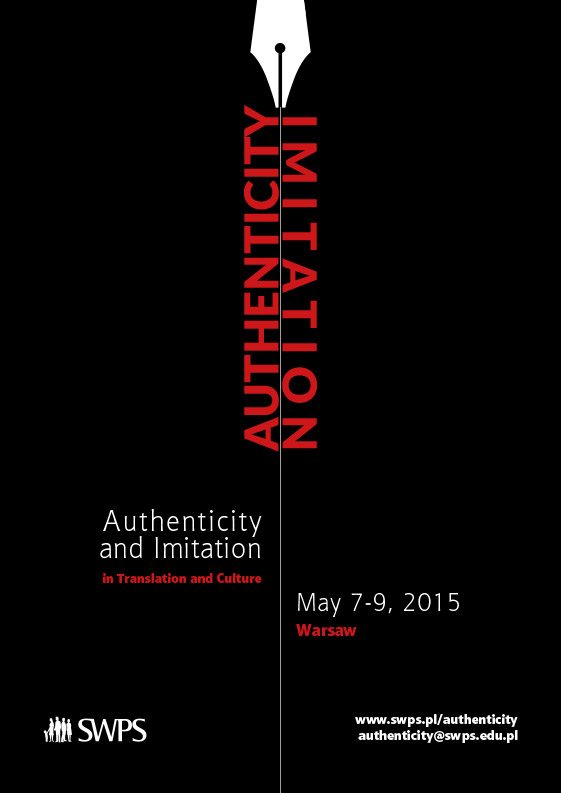Call for Papers
Call for Papers
For Plato, as it is only too well known, imitation was an unwelcome way of bringing falsity to the world. What is connoted by the word "imitation" is first of all a kind of copying, repetition and/or substitution of that which, otherwise, may be modified by the adjective "authentic", applicable to nouns ranging from "life" and "feeling" to "signature", "document" and, of course, "text". Miles Orvell's categories of "culture of imitation" and "culture of authenticity" which he uses to illustrate the passage from the nineteenth-century celebration of replicas to the modernist aesthetic of the authentic may well serve as a point of departure for looking at a range of possible configurations and ways of positioning of authenticity and imitation in contemporary culture. Since culture, and especially Western culture, may be read as a kind of discourse which "is born of translation and in translation", as Henri Meschonnic phrased it, the triad of authenticity, imitation and translation offers an array of issues which seem to be worth an insight and a discussion as a perspective offering ways of rethinking the role of translation in the perception of culture and everyday practices at the time of fluctuation of meanings, an almost omnipresent absence of authenticity and its imitative replacement by all sorts of simulacra.
Long ago, for John Dryden, imitation was a way of authenticating the translator at the cost of the authentic memory of the author. As he put it in his Preface to Ovid's Epistles (1680), "imitation of an author is the most advantageous way for a translator to shew himself, but the greatest wrong which can be done to the memory and reputation of the dead." This wronged memory of the dead and its spectral survival became, almost two hundred years later in the hands of Emerson, a sign of death of the authentic individual: "Imitation is suicide", as he wrote in Self-Reliance. What reverberates in the two statements is not only the old question of constructing graven images and their worship, but also much more recently posited questions of the death of the author and the birth of the reader, of loss and gain in translation, of the invisibility of the translator, of estrangement and defamiliarization, of domesticity and foreigness, of, more generally, a certain politics and poetics of imitation in which authenticity looms large as a constitutive outside to which we inevitably, though sometimes highly critically, relate.
We invite papers and presentations approaching the issues of authenticity, imitation and translation from possibly broadest theoretical and methodological perspectives such as Translation Studies, Literary Criticism, Critical Theory, Cultural Studies, Feminist and Gender Studies, Queer Theory, Philosophy, Sociology, History of Ideas, Colonial and Postcolonial Studies ..., fully realizing that a strictly single-disciplinary approach is nowadays hardly thinkable. We suggest the following, broad, thematic areas only as a topographically drafted chart of the conference:
- Authenticity and translation
- Translation and authorship
- Translation/imitation/creativity
- Translation and nostalgia
- Authenticity and ethnicity
- Imitation and representation
- Imitation, translation and loss
- Imitation, appropriation, replacement
- Imitation and the polysystems of culture
- Authenticity, originality, uniqueness
- Authenticity and intentionality
|
- Estrangement(s)
- Ideology and authenticity
- Authenticity and language
- "Monolingualism" of the authentic
- Authenticity, imitation, self-translation
- Authenticity in and of Translation Studies
- Culture, authenticity, simulacra
- Imitation/mutilation/non-translation
- Authenticity and its others
|
Conference organisers:
- Dr. Agnieszka Pantuchowicz
- Dr. Anna Warso
Keynote
Speakers
Keynote Speakers
Professor Jerzy Jarniewicz
University of Łódź, Poland
TRANSLATING WORDS, APPROPRIATING IMAGES
In 2003 Zbigniew Libera presented his “Positives”, a set of “staged” photographs modeled on a number of famous photographic images documenting some of the key traumatic events of the twentieth century history. A few years later, he collaborated with the Polish poet, Darek Foks, producing a series of works in which portraits of famous film stars of the fifties and sixties were superimposed on documentary photographs of the 1944 Warsaw Uprising. In the nineties, Foks had made himself known as the author of highly influential versions (or “covers”) of poems by Frank O’Hara, which in fact were not O’Hara’s English-language poems, but their Polish translations by the poet and translator Piotr Sommer. It is worth considering these phenomena within the context of other literary practices of today when covers, version and free translations acquire the status of original works (as seen in the works of such poets as Don Paterson or Jo Shapcott). I would claim that there is an analogy, or significant parallelism, between “contemporary art of appropriation”, a vivid movement in visual arts, and the practice of (literary) translation and retranslation. How does this analogy change our understanding of the concept of authenticity and originality? Can “words from words” be seen as equivalents of “images of images”, especially if the images in question are photographs?
Professor Elżbieta Tabakowska
Jagiellonian University, Poland
GENUINE OBJECTS AND IMITATIONS: WHAT DO TRANSLATORS IMITATE? AND DO THEY?
Theorists of (literary) translation are very fond of metaphors. For instance, they say that translating a text written in language A into a text in language B is like copying a picture painted in water colours and producing “the same” picture painted in oils, with water colours and oils standing for different tools found in the translator’s toolbox (which is yet another useful metaphor).
Yet as there is no picture without a painter, so there is no text without an author. Every (literary) text is a representation of a world that is the author’s vision or creation; even if it purports to represent the real, it is always an image of reality as seen from an individual point of view, reflecting an individual perspective, and filtered through a unique individuality. In other words, it is a unique conceptualization, translated into a unique combination of culture- and language-specific verbal expressions. The “genuine thing” is itself a translation, in so much as ideal mimesis is a fiction.
If one were to stick to metaphors pertaining to the domain of visual art, the translator’s task could be compared to the artistic movement known as photorealism, an “artistic simulacrum, where a painting is sometimes created by copying a photograph that is itself a copy of the real”. Yet just as the photograph needed a photographer, so the painted imitation of the photograph needs a painter, whose point of view and perspective, and unique individual filters, become reflected in the painting. So perhaps one should look for an illustrative metaphor in the domain of music, where imitation is defined as “the repetition by one voice of a melody, phrase, or motive stated earlier in the composition by a different voice”.
Two significant questions arise: Is a melody sung by two different voices still “the same” melody? And is the second version necessarily secondary - a simulacrum, an object lacking the value and properties of the genuine thing?
Professor Lawrence Venuti
Temple University, USA
THE POET'S VERSION; OR, AN ETHICS OF TRANSLATION
The poet’s version, a second-order creation that mixes translation and adaptation, emerged in the twentieth century distinct from early modern notions of imitation. It can be illuminated by a hermeneutic model that construes second-order works as an interpretive inscription through the application of formal and thematic interpretants which vary the form, meaning, and effect of the source material, constrained by the receiving medium and culture. If second-order creation is by definition variation, an interpretive act that submits the source material to degrees of loss and gain, then the poet’s version cannot be evaluated simply on the basis of a comparison to its source text. Attention must rather be given to the impact of the version on the receiving culture, a relation that can be construed as properly ethical. The ethics of a version hinges on whether it points to a lack or plenitude in the translating language and culture, challenging or confirming institutionalized knowledge.
BIOS
Jerzy Jarniewicz is a Polish poet, translator and literary critic, who lectures in English at the university of Lodz. He has published twelve volumes of poetry, nine critical books on contemporary Irish, British and American literature and has written extensively for various journals, including Poetry Review, Irish Review, Cambridge Review. He is editor of the literary monthly Literatura na Swiecie (Warsaw) and has translated the work of many novelists and poets, including James Joyce, John Banville, Seamus Heaney, Raymond Carver, Philip Roth, Edmund White, Derek Walcott, Craig Raine, Charles Simic. His most recent work is the anthology Six Irish Women Poets, which he selected and translated.
Elżbieta Muskat-Tabakowska, Ph.D., prof. emer. at the Jagiellonian University of Kraków, Poland. Specializing in Cognitive Linguistics and Translation Studies. Since 1997 member of the Iconicity Research Project. Founder of the UNESCO Chair for Translation Studies and Intercultural Communication at the Jagiellonian University (between 2002 and 2012 acting Head of the Chair). Practising interpreter and translator, specializing in historical narrative; author of numerous published translations, esp. monumental books by the British historian Norman Davies. Her own list of publication includes seven books and over a hundred and fifty articles, published in Poland and abroad. Lectured as visiting professor at several European universities. In 2007 – 2010 member of the group of EU experts for the development of standard translation studies curriculum. Author of an MA programme in TS, selected (2009) for the DGT EMT network of the European Commission.
Professor of English at Temple University, Lawrence Venuti is a translation theorist and historian as well as a translator from Italian, French, and Catalan. He is the author of The Translator’s Invisibility: A History of Translation (2nd ed., 2008), The Scandals of Translation: Towards an Ethics of Difference (1998), and Translation Changes Everything: Theory and Practice (2013), as well as the editor of The Translation Studies Reader (3rd ed., 2012). His translations include the anthology Italy: A Traveler’s Literary Companion (2003), Massimo Carlotto’s crime novel The Goodbye Kiss (2006), and Ernest Farrés’s Edward Hopper: Poems (2009), for which he won the Robert Fagles Translation Prize.
Conference
Programme
Registration
Registration
Clicking the button below will redirect you to the registration form. Upon completing the process, you will receive an automated e-mail containing registration details.
You will be able to pay the conference fee immediately upon registration and later, at a convenient time.
In order to do the latter, access your registration account here.
Please, bear in mind that the deadline for registration and payment of the conference fee for participant presenting papers is March 28, 2015.
Accommodation
& Venue
Venue:

The conference venue will be located in the main building of the University of Social Sciences and Humanities, ul. Chodakowska 19/31, Warsaw.
You can also use one of the taxi services; Ele Taxi cars (22 811 11 11) can be found at the Chopin Airport just outside the terminal.
Accommodation
Our Recommendation
Hotel Hetman *** is conveniently located on the east side of the Vistula river, less than 10 minutes by tram from the conference venue (tram no 26 taken in the opposite direction goes past the ZOO and across the river to stop right at the foot of Warsaw's Old Town).
The hotel offers special conference rates, guaranteed until the end of March.
| |
weekday rate |
weekend rate
(Friday through Sunday) |
single room,
breakfast included |
259 PLN |
149 PLN |
double room,
breakfast included |
299 PLN |
179 PLN |
In order to take advantage of the preference rate, book through the reception by e-mailing the hotel (This email address is being protected from spambots. You need JavaScript enabled to view it.) and referencing University of Social Sciences and Humanities: SWPS.
Other Hotels
Warsaw has a good hotel base and offers a wide range of accommodation types. It is advisable to make sure that the chosen hotel is located near one of the tram lines crossing the river (preferably lines no 26 or 22).
Posters
& Photos
Conference Posters



Conference Photos
{myFlickr}feed=photoset,photoset_id= 72157675676293725,displaymode=gallery{/myFlickr}